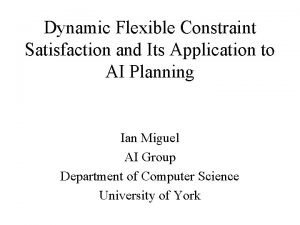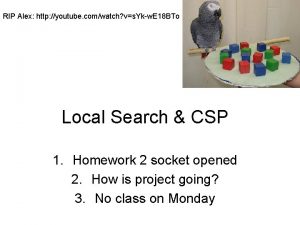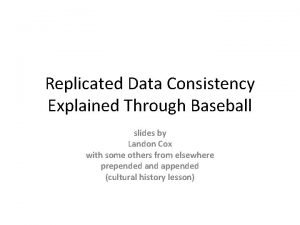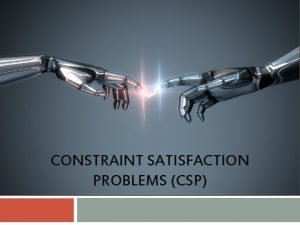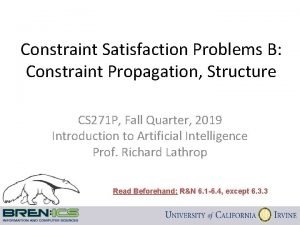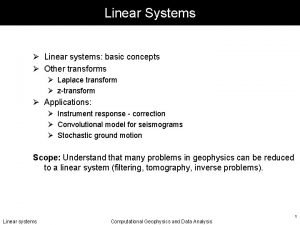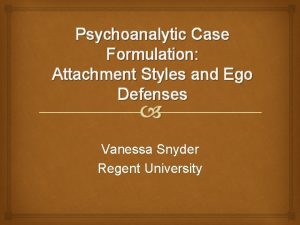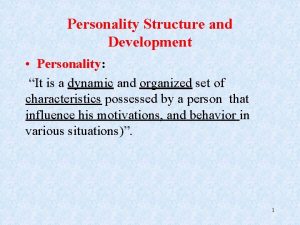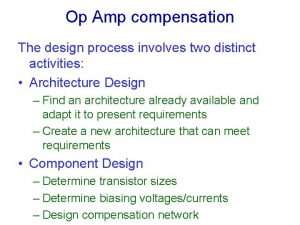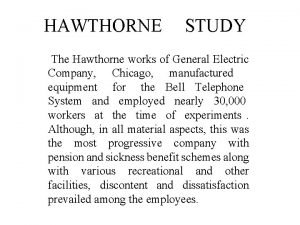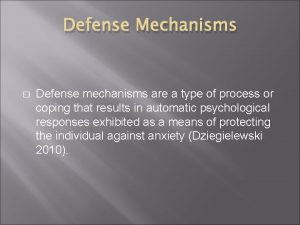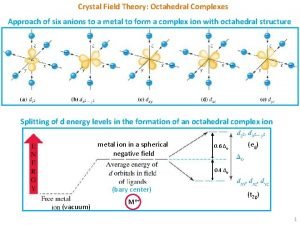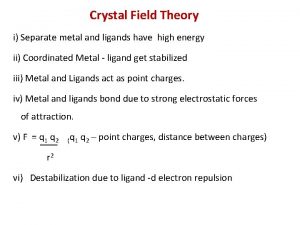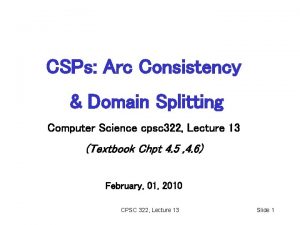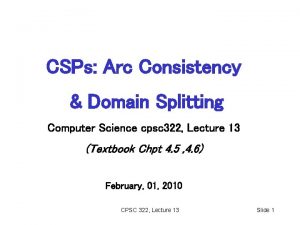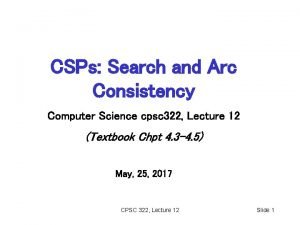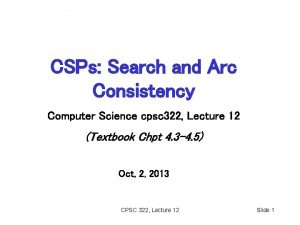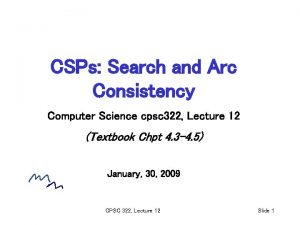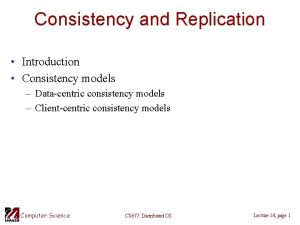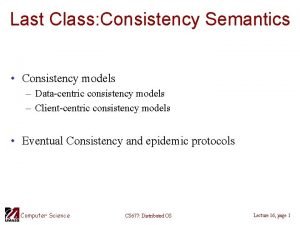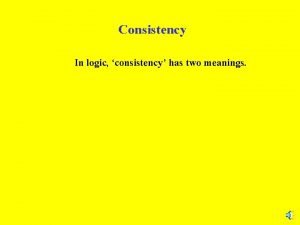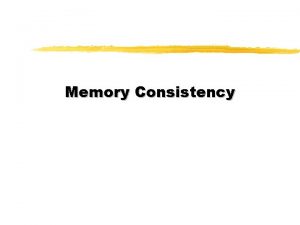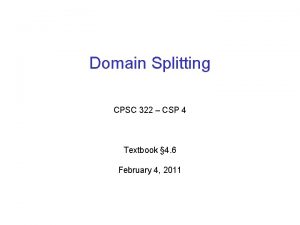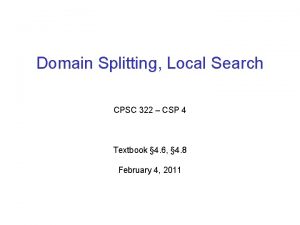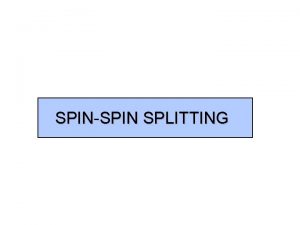Arc Consistency and Domain Splitting in CSPs CPSC




































- Slides: 36

Arc Consistency and Domain Splitting in CSPs CPSC 322 – CSP 3 Textbook Poole and Mackworth: § 4. 5 and 4. 6 Lecturer: Alan Mackworth October 3, 2012

Lecture Overview • Solving Constraint Satisfaction Problems (CSPs) - Recap: Generate & Test - Recap: Graph search • Arc consistency - GAC algorithm - Complexity analysis - Domain splitting 2

Constraint Satisfaction Problems (CSPs): Definition: A constraint satisfaction problem (CSP) consists of: • a set of variables V • a domain dom(V) for each variable V V • a set of constraints C Definition: A possible world of a CSP is an assignment of values to all of its variables. Definition: A model of a CSP is a possible world that satisfies all constraints. An example CSP: • V = {V 1, V 2} – – • dom(V 1) = {1, 2, 3} dom(V 2) = {1, 2} C = {C 1, C 2, C 3} – – – C 1 : V 2 2 C 2 : V 1 + V 2 < 5 C 3 : V 1 > V 2 Possible worlds for this CSP: {V 1=1, V 2=1} {V 1=1, V 2=2} {V 1=2, V 2=1} (one model) {V 1=2, V 2=2} {V 1=3, V 2=1} (another model) {V 1=3, V 2=2} 3

Generate and Test (G&T) Algorithms • Generate and Test: - Generate possible worlds one at a time. - Test constraints for each one. Example: 3 variables A, B, C For a in dom(A) For b in dom(B) For c in dom(C) if {A=a, B=b, C=c} satisfies all constraints return {A=a, B=b, C=c} fail • Simple, but slow: - k variables, each domain size d, c constraints: O(cdk) 4

Lecture Overview • Solving Constraint Satisfaction Problems (CSPs) - Recap: Generate & Test - Recap: Graph search • Arc consistency - GAC algorithm - Complexity analysis - Domain splitting 5

Backtracking algorithms • Explore search space via DFS but evaluate each constraint as soon as all its variables are bound. • Any partial assignment that doesn’t satisfy the constraint can be pruned. • Example: - 3 variables A, B, C, each with domain {1, 2, 3, 4} - {A = 1, B = 1} is inconsistent with constraint A B regardless of the value of the other variables Fail. Prune! 6

CSP as Graph Searching Check unary constraints on V 1 If not satisfied PRUNE {} V 1 = v 1 Check constraints on V 1 and V 2 If not satisfied PRUNE V 1 = v 1 V 2 = v 1 V 3 = v 1 V 1 = v 1 V 2 = v 1 V 3 = v 2 V 1 = v 1 V 2 = v 2 V 1 = v k V 1 = v 1 V 2 = v k

Standard Search vs. Specific R&R systems • Constraint Satisfaction (Problems): – – – State: assignments of values to a subset of the variables Successor function: assign values to a ‘free’ variable Goal test: all variables assigned a value and all constraints satisfied? Solution: possible world that satisfies the constraints Heuristic function: none (all solutions at the same distance from start) • Planning : – – – State Successor function Goal test Solution Heuristic function • Inference – – – State Successor function Goal test Solution Heuristic function 8

CSP as Graph Searching Check unary constraints on V 1 If not satisfied PRUNE {} V 1 = v 1 Check constraints on V 1 and V 2 If not satisfied PRUNE V 1 = v 1 V 2 = v 1 V 3 = v 1 V 1 = v 1 V 2 = v 1 V 3 = v 2 V 1 = v 1 V 2 = v 2 V 1 = v k V 1 = v 1 V 2 = v k Problem? Performance heavily depends on the order in which variables are considered. E. g. only 2 constraints: Vn=Vn-1 and Vn Vn-1

CSP as a Search Problem: another formulation • States: partial assignment of values to variables • Start state: empty assignment • Successor function: states with the next variable assigned – Assign any previously unassigned variable – A state assigns values to some subset of variables: • E. g. {V 7 = v 1, V 2 = v 1, V 15 = v 1} • Neighbors of node {V 7 = v 1, V 2 = v 1, V 15 = v 1}: nodes {V 7 = v 1, V 2 = v 1, V 15 = v 1, Vx = y} for some variable Vx V {V 7, V 2, V 15} and all values y dom(Vx) • Goal state: complete assignments of values to variables that satisfy all constraints – That is, models • Solution: assignment (the path doesn’t matter) 10

CSP as Graph Searching • 3 Variables: A, B, C. All with domains = {1, 2, 3, 4} • Constraints: A<B, B<C

Selecting variables in a smart way • Backtracking relies on one or more heuristics to select which variables to consider next. - E. g. variable involved in the largest number of constraints: “If you are going to fail on this branch, fail early!” - Can also be smart about which values to consider first • This is a different use of the word ‘heuristic’! - Still true in this context • Can be computed cheaply during the search • Provides guidance to the search algorithm - But not true anymore in this context • ‘Estimate of the distance to the goal’ • Both meanings are used frequently in the AI literature. • ‘heuristic’ means ‘serves to discover’: goal-oriented. • Does not mean ‘unreliable’! 12

Learning Goals for solving CSPs so far • Verify whether a possible world satisfies a set of constraints i. e. whether it is a model - a solution. • Implement the Generate-and-Test Algorithm. Explain its disadvantages. • Solve a CSP by search (specify neighbors, states, start state, goal state). Compare strategies for CSP search. Implement pruning for DFS search in a CSP. 13

Lecture Overview • Solving Constraint Satisfaction Problems (CSPs) - Recap: Generate & Test - Recap: Graph search • Arc consistency - GAC algorithm - Complexity analysis - Domain splitting 14

Can we do better than Search? Key idea • prune the domains as much as possible before searching for a solution. Def. : A variable is domain consistent if no value of its domain is ruled impossible by any unary constraints. • Example: dom(V 2) = {1, 2, 3, 4}. V 2 2 • Variable V 2 is not domain consistent. - It is domain consistent once we remove 2 from its domain. • Trivial for unary constraints. Trickier for k-ary ones. 15

Graph Searching Repeats Work • 3 Variables: A, B, C. All with domains = {1, 2, 3, 4} • Constraints: A<B, B<C • A ≠ 4 is rediscovered 3 times. So is C ≠ 1 - Solution: remove values from A’s domain and C’s, once and for all

Constraint network: definition Def. A constraint network is defined by a graph, with - one node for every variable (drawn as circle) - one node for every constraint (drawn as rectangle) - undirected edges running between variable nodes and constraint nodes whenever a given variable is involved in a given constraint. • Example: - Two variables X and Y - One constraint: X<Y X X< Y Y 17

Constraint network: definition Def. A constraint network is defined by a graph, with - one node for every variable (drawn as circle) - one node for every constraint (drawn as rectangle) - Edges/arcs running between variable nodes and constraint nodes whenever a given variable is involved in a given constraint. • Whiteboard example: 3 Variables A, B, C – 3 Constraints: A<B, B<C, A+3=C – 6 edges/arcs in the constraint network: • �A, A<B� , �B, A<B� • �B, B<C� , �C, B<C� • �A, A+3=C� , �C, A+3=C� 18

A more complicated example • How many variables are there in this constraint network? 5 6 9 14 – Variables are drawn as circles • How many constraints are there? 5 6 9 14 – Constraints are drawn as rectangles 19

Arc Consistency Definition: An arc <x, r(x, y)> is arc consistent if for each value x in dom(X) there is some value y in dom(Y) such that r(x, y) is satisfied. A network is arc consistent if all its arcs are arc consistent. B A 2, 3 A< B 1, 2, 3 Not arc consistent: No value in domain of B that satisfies A<B if A=3 Is this arc consistent? T F A 2, 5, 7 Arc consistent: Both B=2 and B=3 have ok values for A (e. g. A=1) T F A< B/2 B 2, 3, 13 20

How can we enforce Arc Consistency? • If an arc <X, r(X, Y)> is not arc consistent - Delete all values x in dom(X) for which there is no corresponding value in dom(Y) - This deletion makes the arc <X, r(X, Y)> arc consistent. - This removal can never rule out any models/solutions • Why? Y X 2, 3, 4 X< Y 1, 2, 3 Run this example: http: //cs. ubc. ca/~mack/CS 322/AIspace/simple-network. xml in ( (Save to a local file and open file. ) 21

Lecture Overview • Solving Constraint Satisfaction Problems (CSPs) - Recap: Generate & Test - Recap: Graph search • Arc consistency - GAC algorithm - Complexity analysis - Domain splitting 22

Arc Consistency Algorithm: high level strategy • Consider the arcs in turn, making each arc consistent • Reconsider arcs that could be made inconsistent again by this pruning of the domains • Eventually reach a ‘fixed point’: all arcs consistent • Run ‘simple problem 1’ in AIspace for an example: 23

Which arcs need to be reconsidered? • When we reduce the domain of a variable X to make an arc X, c arc consistent, which arcs do we need to reconsider? Z 1 Z 2 Z 3 T c 1 H E c 2 S E c 3 every arc Z, c' where c’ c involves Z and X: X c Y c 4 A • You do not need to reconsider other arcs - If arc Y, c was arc consistent before, it will still be arc consistent - If an arc X, c' was arc consistent before, it will still be arc consistent 24 - Nothing changes for arcs of constraints not involving X

Which arcs need to be reconsidered? • Consider the arcs in turn, making each arc consistent • Reconsider arcs that could be made inconsistent again by this pruning • DO trace on ‘simple problem 1’ and on ‘scheduling problem 1’, trying to predict - which arcs are not consistent and which arcs need to be reconsidered after each removal in 25

Arc consistency algorithm (for binary constraints) Procedure GAC(V, dom, C) Inputs V: a set of variables dom: a function such that dom(X) is the domain of variable X C: set of constraints to be satisfied Scope of constraint c is Output the set of variables arc-consistent domains for each variable TDA: involved in that Local To. Do. Arcs, constraint blue arcs DX is a set of values for each variable X TDA is a set of arcs in AIspace 1: for each variable X do 2: DX ←dom(X) 3: TDA ←{� X, c� | X ∈ V, c ∈ C and X ∈ scope(c)} NDX: values x for X for 4: while (TDA {}) which there a value for y 5: select � X, c�∈TDA supporting x 6: TDA ←TDA {� X, c� } 7: NDX ←{x| x ∈ DX and y ∈ DY s. t. (x, y) satisfies c} 8: if (NDX DX) then 9: TDA ←TDA ∪ { � Z, c'�| X ∈ scope(c'), c' c, Z 10: DX ←NDX 11: return {DX| X is a variable} X’s domain changed: arcs (Z, c’) for variables Z sharing a constraint c’ with X could become inconsistent ∈ scope(c') {X} } 26

Arc Consistency Algorithm: Interpreting Outcomes • Three possible outcomes (when all arcs are arc consistent): – Each domain has a single value, e. g. http: //www. cs. ubc. ca/~mack/CS 322/AIspace/simple-network. xml (Download the file and load it as a local file in AIspace) • We have a (unique) solution. – At least one domain is empty, e. g. http: //www. cs. ubc. ca/~mack/CS 322/AIspace/simple-infeasible. xml • No solution! All values are ruled out for this variable. – Some domains have more than one value, e. g. built-in example “simple problem 2” • There may be a solution, multiple ones, or none • Need to solve this new CSP (usually simpler) problem: same constraints, domains have been reduced

Lecture Overview • Solving Constraint Satisfaction Problems (CSPs) - Recap: Generate & Test - Recap: Graph search • Arc consistency - GAC algorithm - Complexity analysis - Domain splitting 28

Arc Consistency Algorithm: Complexity • Worst-case complexity of arc consistency procedure on a problem with N variables – let d be the max size of a variable domain – let c be the number of constraints • How often will we prune the domain of variable V? O(d) times • How many arcs will be put on the To. Do. Arc list when pruning domain of variable V? - O(degree of variable V) In total, across all variables: sum of degrees of all variables = 2*number of constraints, i. e. 2*c • Together: we will only put O(dc) arcs on the To. Do. Arc list • Checking consistency is O(d 2) for each of them • Overall complexity: O(cd 3) • Compare to O(d. N) of DFS!! Arc consistency is MUCH faster

Lecture Overview • Solving Constraint Satisfaction Problems (CSPs) - Recap: Generate & Test - Recap: Graph search • Arc consistency - GAC algorithm - Complexity analysis - Domain splitting 30

Can we have an arc consistent network with non-empty domains that has no solution? YES NO • Example: vars A, B, C with domain {1, 2} and constraints A ≠ B, B ≠ C, A ≠ C • Or see AIspace CSP applet Simple Problem 2

Domain splitting (or case analysis) • Arc consistency ends: Some domains have more than one value may or may not have a solution A. Apply Depth-First Search with Pruning or B. Split the problem in a number of disjoint cases: CSP with dom(X) = {x 1, x 2, x 3, x 4} becomes CSP 1 with dom(X) = {x 1, x 2} and CSP 2 with dom(X) = {x 3, x 4} • Solution to CSP is the union of solutions to CSPi 32

Domain splitting • Each smaller CSP is easier to solve – Arc consistency might already solve it • For each sub. CSP, which arcs have to be on the To. Do. Arcs list when we get the sub. CSP by splitting the domain of X? arcs <Z, r(Z, X)> and <X, r(Z, X)> All arcs A 1 A 2 A 3 T c 1 H E c 2 S E c 3 X c T H I S Y c 4 A

Domain splitting in action • Trace it on “simple problem 2”

Searching by domain splitting CSP, apply AC If domains with multiple values Split on one CSP 1, apply AC If domains with multiple values Split on one CSP 2, apply AC If domains with multiple values…. . Split on one How many CSPs do we need to keep around at a time? With depth m and 2 children at each split: O(2 m). It’s a DFS. 35

Learning Goals for today’s class • Define/read/write/trace/debug the arc consistency algorithm. Compute its complexity and assess its possible outcomes • Define/read/write/trace/debug domain splitting and its integration with arc consistency • Coming up: local search, Section 4. 8
 Flexible csp relax on
Flexible csp relax on Csps youtube
Csps youtube Bitcoin
Bitcoin Arc consistency sudoku
Arc consistency sudoku Arc consistency sudoku
Arc consistency sudoku Mentoring circle
Mentoring circle Minor arc and major arc
Minor arc and major arc Arc promoteur vs arc investigateur
Arc promoteur vs arc investigateur Arc emu88 com arc info 18 100018 html
Arc emu88 com arc info 18 100018 html Domain codomain range
Domain codomain range Data domain fundamentals
Data domain fundamentals A_______ bridges the specification gap between two pls.
A_______ bridges the specification gap between two pls. Z domain to frequency domain
Z domain to frequency domain Roc in z transform
Roc in z transform Z transform integrator
Z transform integrator Domain specific vs domain general
Domain specific vs domain general Domain specific software engineering
Domain specific software engineering Problem domain vs knowledge domain
Problem domain vs knowledge domain S domain to z domain
S domain to z domain Bpd splitting
Bpd splitting Enmeshment trauma
Enmeshment trauma Teori medan kristal
Teori medan kristal Splitting of s2
Splitting of s2 Fixed split s2 causes
Fixed split s2 causes Primitive coping mechanism
Primitive coping mechanism Examples of passive-aggressive
Examples of passive-aggressive Personailty disorders
Personailty disorders Amplifier compensation plan
Amplifier compensation plan Http response splitting example
Http response splitting example Splitting heart sounds
Splitting heart sounds Mica splitting test room
Mica splitting test room Autistic fantasy defense mechanism example
Autistic fantasy defense mechanism example Crystal field theory for tetrahedral complexes
Crystal field theory for tetrahedral complexes Square planar crystal field
Square planar crystal field Splitting of square planar complex
Splitting of square planar complex Clean edge razor
Clean edge razor Hildegard peplau levels of anxiety
Hildegard peplau levels of anxiety
